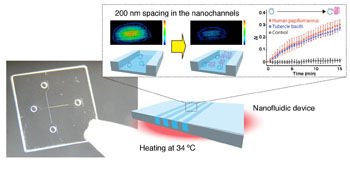Nanofluidic Diffraction Grating Technique for DNA Amplification May Replace PCR
By LabMedica International staff writers
Posted on 21 Sep 2016
A team of Japanese biophysicists suggests replacing the RT-PCR (real time polymerase chain reaction) technique with a rapid label-free detection method for real-time DNA amplification using a nanofluidic diffraction grating.Posted on 21 Sep 2016
Investigators at Nagoya University (Japan) based their strategy for quantifying DNA amplification in a label-free manner on observations of intensity changes of diffracted light derived from the passage of a laser beam through nanochannels embedded in a microchannel; the ability to diffract the beam is a basic characteristic of nanochannels.

Image: A photo and a schematic illustration for a nanofluidic diffraction grating. Label-free signals based on a diffraction intensity change were attributed to amplification of DNA molecules, such as human papillomavirus and tubercle bacilli (Photo courtesy of Takao Yasui, Nagoya University).
In practice, they fabricated 2.7 micron deep, 200 nanometer wide periodic nanochannels embedded in microchannels, which were etched on fused silica substrates by electron beam lithography, photolithography, and plasma etching. For an incident laser beam they used a modulated 532 nanometer laser to amplify a specific component extracted from random or background noise.
They investigators reported in the August 17, 2016, online edition of the journal Scientific Reports that numerical simulations revealed that the diffracted light intensity change in the nanofluidic diffraction grating was attributed to the change of refractive index. Using the technique, they demonstrated the first case reported to date for label-free detection of real-time DNA amplification, such as specific DNA sequences from tubercle bacilli (TB) and human papillomavirus (HPV). Since the system allowed quantification of the initial concentration of amplified DNA molecules ranging from one femtomolar to one picomolar, the investigators expect that it will offer a new strategy for developing fundamental techniques of medical applications.
"Our system also measures DNA amplification at the relatively low temperature of 34 degrees Celsius and without the need for thermal cycles," said contributing author Dr. Noritada Kaji, associate professor of engineering at Nagoya University. "Because it has the potential to be constructed as a single chip and can detect sample volumes as small as one microliter, which is 100-1,000 times less than conventional detectors are capable of, it is particularly suited to development as a miniaturized form of diagnostics and microbe detection."
Related Links:
Nagoya University














